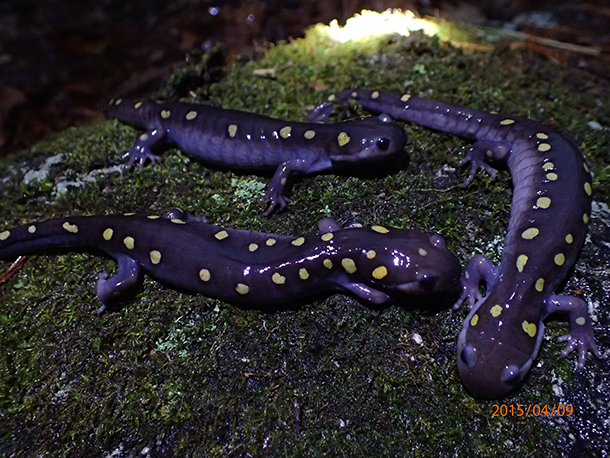Microbes Fight Fungal Disease in Frogs
Air Date: Week of February 26, 2016

Spotted salamanders, Ambystoma maculatum, from Milton, MA. (Photo: Doug Woodhams)
Fighting the fungal diseases that have killed millions of frogs and other amphibians is a top priority, and new research suggests natural soil bacteria might provide protection. UMass Boston biology professor Doug Woodhams tells Living on Earth’s Helen Palmer how they work.
Transcript
CURWOOD: And there is more good news beyond the actions taken by the Fish and Wildlife Service to keep infected salamanders out of the US as part of the fight against fungal diseases that are devastating animal populations. Biologists also see some potential hope in soil bacteria that get onto the skins of salamanders and frogs. Doug Woodhams is an assistant professor of biology at UMass Boston, who’s been working with amphibians in Panama – and he explained what his team has found to Living on Earth’s Helen Palmer.
PALMER: Now, we’ve just been hearing about the terrible problems that seem to be attacking many different species at the moment, many fungal diseases — things like white nose syndrome. You’ve been looking at the kind of diseases that attack frogs and salamanders, and you’ve found some good news.
WOODHAMS: Yes, so some of the amphibians have beneficial bacteria that live on their skin, and these have anti-fungal properties.
PALMER: This is kind of like having good bacteria in your gut, for instance, that stop you from getting sick.
WOODHAMS: Exactly, yeah. So the amphibian skin is a mucosal surface, just like our guts. And they are also protected by microbiota.
PALMER: And is there any evidence that these good bacteria actually work against these devastating funguses?
WOODHAMS: Yeah, there’s quite a bit of evidence. Many of the bacteria that we can culture from some amphibian species are able to inhibit the fungus in culture. We also have some population-level data that shows populations that tend to have these anti-fungal bacteria can persist with Bd in the environment and survive—
PALMER: Bd is?
WOODHAMS: Bd is the chytrid fungus that’s been spreading around the world and devastating amphibian populations. So salamanders, frogs, toads, they’re susceptible to chytrid fungus.

Doug Woodhams studies disease ecology and teaches at the University of Massachusetts Boston. (Photo: Harry Brett)
PALMER: We’ve seen the chytrid fungus that affects frogs spread all around the world and wipe out massive amounts, particularly of certain frogs. If the salamander fungus is not here, then presumably the danger is once it gets here it will have a similarly devastating effect because they won’t have any immunity.
WOODHAMS: Absolutely, and that’s why — you know, it may be only a matter of time before it arrives. So that’s why there’s a recent increase in the concern and research activity, trying to figure out which amphibians, which salamanders — even frogs may be susceptible, we don’t know yet. And especially in the Appalachians, where it’s the world’s hotspot of salamander biodiversity, we really want to keep this new salamander chytrid out. And if we can’t, then we need some tools, for example, probiotics or anti-fungal treatments, that may be able to help.
CURWOOD: That’s just a taste of what UMass Boston biology professor Doug Woodhams told LOE’s Helen Palmer about the new discoveries that might help save salamanders and perhaps other wildlife under threat from fungal diseases. We’ll have the full interview next week.
Links
Dr. Woodhams’ paper, “Managing Amphibian Disease with Skin Microbiota”
About Bd and other chytrid fungi
About the Bsal salamander fungus
Elizabeth Kolbert, “What’s Causing Deadly Outbreaks of Fungal Diseases in World’s Wildlife?”
Living on Earth wants to hear from you!
Living on Earth
62 Calef Highway, Suite 212
Lee, NH 03861
Telephone: 617-287-4121
E-mail: comments@loe.org
Newsletter [Click here]
Donate to Living on Earth!
Living on Earth is an independent media program and relies entirely on contributions from listeners and institutions supporting public service. Please donate now to preserve an independent environmental voice.
NewsletterLiving on Earth offers a weekly delivery of the show's rundown to your mailbox. Sign up for our newsletter today!
 Sailors For The Sea: Be the change you want to sea.
Sailors For The Sea: Be the change you want to sea.
 The Grantham Foundation for the Protection of the Environment: Committed to protecting and improving the health of the global environment.
The Grantham Foundation for the Protection of the Environment: Committed to protecting and improving the health of the global environment.
 Contribute to Living on Earth and receive, as our gift to you, an archival print of one of Mark Seth Lender's extraordinary wildlife photographs. Follow the link to see Mark's current collection of photographs.
Contribute to Living on Earth and receive, as our gift to you, an archival print of one of Mark Seth Lender's extraordinary wildlife photographs. Follow the link to see Mark's current collection of photographs.
 Buy a signed copy of Mark Seth Lender's book Smeagull the Seagull & support Living on Earth
Buy a signed copy of Mark Seth Lender's book Smeagull the Seagull & support Living on Earth

